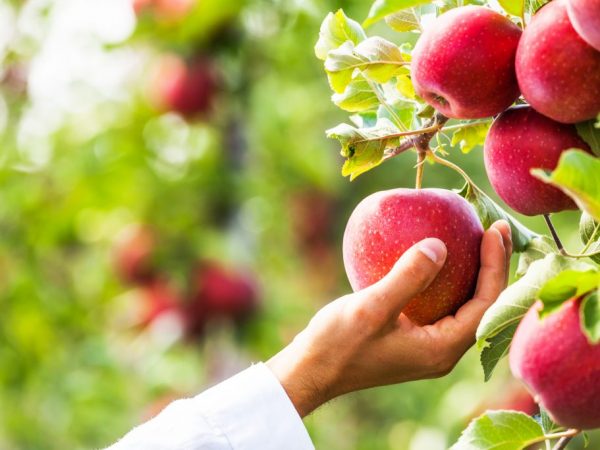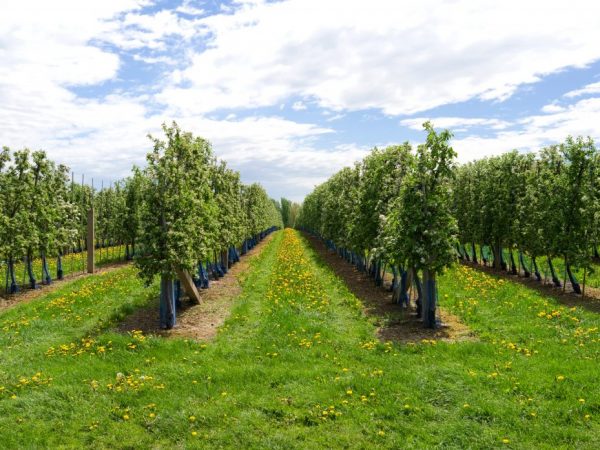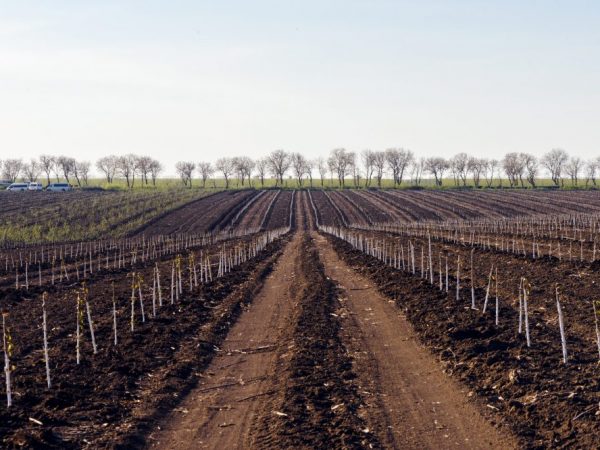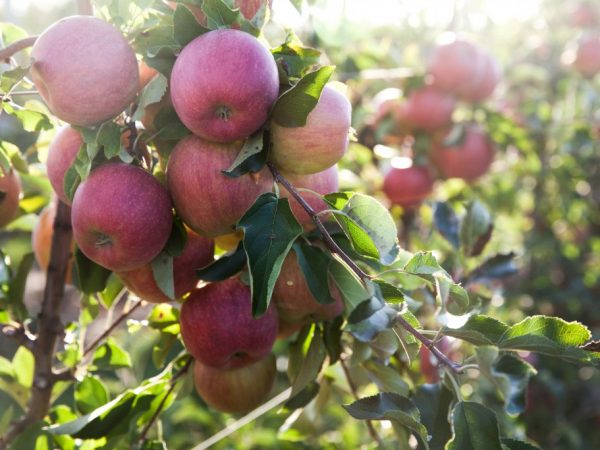Apple variety Gift for Gardeners
The apple variety "Gift to Gardeners" received its wide zoning in 1998. At first it spread only in the Siberian region, but over time it went beyond it and began to be in wide demand in Altai and its environs.
- Characteristics of the variety
- Description of the tree and fruit
- Taste
- Yield
- Pollinators
- Winter hardiness
- Disease resistance
- Selection of seedlings
- Landing
- Timing
- Training
- Landing technology
- Care
- Watering
- Top dressing
- Preventive treatment
- Pruning and shaping the crown
- Features of ripening and fruiting
- Harvesting and storage
- Growing in different regions
- Gardeners reviews
- Dignity
- disadvantages

Apple variety Gift for Gardeners
Characteristics of the variety
The apple variety is loved for its versatility. It is winter-hardy and fertile, gardeners boldly choose it for their home plot and garden grounds.
The fruits retain their presentation for a long time and are excellent for transportation over any distance.
Description of the tree and fruit
An adult tree has a round, compact crown shape. It belongs to medium-sized, grows in height up to 3 m. The trunk and branches are brown in color with a slight red tint, young shoots are different, they are slightly lighter.
Gray-green leaves, in size can be attributed to medium, have an elliptical shape, slightly narrowed at the end, and have notches along the edge. There is a slight fluffiness under the leaf.
Fruits are small, their weight rarely exceeds 100 g, in general, they are 70-80 g. They are round in shape, slightly flattened towards the center.
Apple Gift is yellow-green, with a beautiful blush that covers most of the fruit. They are fragrant and healthy, because the pulp contains 25/100 g of ascorbic acid and 13/100 g of natural glucose.
The versatility of the variety lies in the possibility of using it in private gardening and for commercial sale over a long period.
Taste
Fine-grained pulp, sweet and sour taste. It is crispy and juicy, white with a slightly light green tint.
Yield
Autumn variety Gift cannot be attributed to high-yielding: on average, one apple tree can harvest 30 kg per season. This is a good option for growing a tree in the country for your family, given the long shelf life of the fruits - almost until the end of spring.
The crop is ready for harvest in mid-September and for 120 days it is guaranteed to retain its original presentation. The apple tree bears fruit steadily, starting from the 3-4th year of life.
Pollinators
The apple tree does not need obligatory cross-pollination, it is self-fertile.
Winter hardiness

The variety is resistant to severe frosts.
According to the description, the variety has average winter hardiness, but it is good because it quickly regenerates. He is not afraid of strong temperature changes and prolonged frosts.
Disease resistance
A gift for gardeners is immune to scab, but it is impossible to guarantee 100% endurance of an apple tree to insect pests, with a large number of them, intervention will be required. Rodents are also dangerous, they can damage the bark of the trunk and roots of the plant.
Only timely prevention will help prevent problems with diseases characteristic of the culture: you need to regularly clean the site of weeds, which are the causes of ailments.
Selection of seedlings
It is important to approach responsibly the choice of planting material.
- Choose seedlings that are 1-2 years old, they are more likely to take root well in a new place.
- The plant should have a well-developed root system, check carefully the roots for rot, growths and thickenings, it is better not to take such seedlings.
- Remember that the plant does not tolerate drought. This also applies to young seedlings. The roots should be moist, ideally with remnants of the soil in which they grew. Many sellers transport seedlings wrapped in a damp cloth - that's right. If the roots are dry, their recovery and further adaptation will be difficult.
- The seedling should have a smooth bark.
- Material with expanded buds is not suitable for planting; buds should only be swollen.
Landing
The planting process cannot be called troublesome, but it requires certain knowledge from the gardener. After choosing the planting material, you need to take care of its correct planting.
Timing
Depending on the region, planting dates are chosen. In almost all areas, planting in the fall is advised: in mid-October. The plant will develop the root system better during the winter.
In areas where autumn is dry, windy and cold, it is better to plant trees in the spring, in March-April, when the snow melts and the sun warms up.
Training
Like any fruiting tree, it doesn't like drafts. For landing, you should choose a place that is sunny, not windy. The land should not be depleted by previous crops. That is, do not plant in a place where another tree has just been uprooted. It takes a couple of years for the soil to recover. The site is cleared of weeds and debris.
Check the distance to groundwater, it should be at least 1.5-2 m, otherwise there is a risk of root rot. The soil should be loamy and retain moisture well. The presence of stone and rubble in it is highly undesirable. If the soil is mainly clay, mix it with sand, and if it is sandy, then a layer is formed from the clay to retain moisture.
The holes for the trees should be dug earlier: a month before the purchase and planting of seedlings, and if not, then at least a week. The size for landing should be 100 cm wide and 60-80 cm deep.
Separate the top soil and mix it with humus, peat, manure or compost. We will continue to fill in the planting material with this mixture. If possible, use mineral fertilizers in moderation.
Landing technology

Young trees need frequent watering
- We prepare holes for planting with an interval of 3-4 m between each other and from other trees and shrubs;
- We place a seedling in the hole and gently straighten the roots, it is advisable to immediately dig in the support for the young tree;
- We fill the pit with the seedling with the prepared mixture;
- We compact the soil, form a near-stem circle;
- Watering a new plant;
- We provide the root collar with an elevation above the soil with a height of 5-6 cm;
- We mulch with dry grass, straw or sawdust.
Care
Watering
According to the description, a young apple tree needs more frequent watering as soon as the hole near the trunk dries up. Older trees are watered less often, but from early spring to the first frost, about once every 2-3 weeks, but it all depends on the region and its weather and climatic characteristics.
Watering is especially important before flowering, during the period of fruit filling, after leaf fall. Watering will be more frequent during hot summers.
Top dressing
Someone may think that feeding the tree is not necessary, but this is far from the case. Growth on poor sandy-clay soils is not easy for plants. Timely feeding will give you a good harvest.
In the early years, before the beginning of fruiting, the plant is fertilized with mullein infusion and a little complex fertilizers are applied at the beginning of summer.When the tree begins a period of active flowering, then it's time to use organic fertilizers, namely compost and humus.
Autumn dressing consists of mineral fertilizers and ash.
Preventive treatment
In order to prevent scab damage in a wet year, tinder fungus and other diseases and pests, it is advised to take the following preventive measures:
- spray trees with sulfur and copper sulfate, pests do not like them;
- whitewash trunks in the spring;
- make the necessary top dressing on time;
- shape the crown correctly.
Pruning and shaping the crown
Timely crown formation by pruning and removing excess pagons and branches contributes to an earlier onset of fruiting. Pruning is carried out twice a year: in autumn and spring. It allows the tree to tolerate wintering better.
Places of cuts are subject to primary treatment with copper sulfate and secondary garden varnish. There is one caveat here: young branches are treated with garden pitch on the 2nd day after pruning, and older ones on the same day.
The best pruning scheme is sparse-tiered. Leave 3-4 branches on the trunk, which will form the basis of the crown. The rest of the shoots are removed by a third so that the buds look in the direction opposite to the trunk. Do not allow the crown to thicken. Between the two lower main branches, a distance of 0.5 m is desirable.
The apex is cut off only in the case of a small annual increase.
Features of ripening and fruiting

During fruiting, the tree must be fed.
The beginning of fruiting directly depends on the correct pruning and timely feeding.
Please note: if the tree does not have enough moisture during the period of fruit filling, then it begins to shed its foliage in order to preserve the harvest. Water and feed the plant in time.
Harvesting and storage
You can start harvesting in mid-September. So the fruits will last for the next 4 months, but practice shows that this period is much longer.
The crop is placed in dry wooden boxes and placed in a cool, dark dry area with adequate ventilation. Check the fruit periodically for spoilage.
Apples tolerate transportation well.
Growing in different regions
The variety is widely zoned. Better he shows his features in the Siberian region. It takes root and grows well in the Altai region and the southern part of Russia, but requires more careful care.
Gardeners reviews
The Apple Tree Gift for Gardeners is appreciated by gardeners for its easy care and excellent results, which is measured not by the quantity, but by the quality of the crop.
Delicious and aromatic apples are stored for a long time and delight the owners until spring - this is the result that is obtained in a small amount of time.
Dignity
- high winter hardiness and fast regenerative ability;
- long-term preservation of fruits;
disadvantages
- it is necessary to constantly keep the soil moist; when it dries, the tree begins to wither;
- fruits do not exceed medium size.

